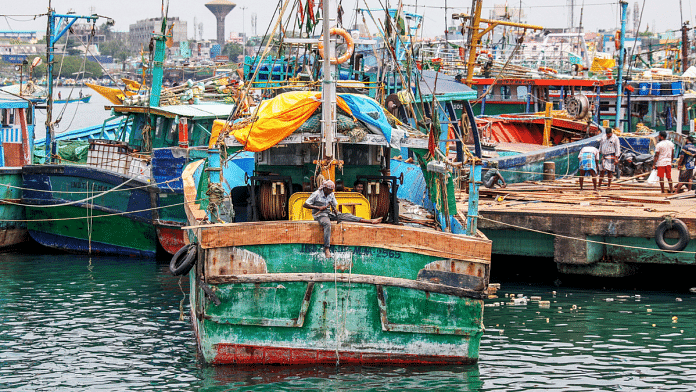New Delhi: New Delhi recognised the barren and uninhabited island of Katchatheevu as Sri Lankan territory in 1974 and Colombo later recognised the resource-rich, deep-sea fishing grounds of Wadge Bank as Indian territory in 1976, an analysis of two maritime boundary agreements between India and Sri Lanka shows.
A political row has broken out over the 1.6-km-long island of Katchatheevu ahead of the 2024 Lok Sabha elections, with Prime Minister Narendra Modi blaming the Congress for “callously” giving away the island. Tamil Nadu state Bharatiya Janata Party (BJP) chief K. Annamalai first said the island was given away Sunday after obtaining an RTI reply on the matter.
However, after Katchatheevu was recognised as Sri Lankan territory in 1974, Sri Lanka withdrew its claim over Wadge Bank through the 1976 agreement, recognising New Delhi’s sovereignty in the fishing-rich area and creating the possibility for Indian fishermen to use the area’s resources.
Sri Lankan fishermen had been using trawlers to commercially fish in Wadge Bank — a continental shelf nearly 80 kilometres (50 miles) seaward from the coast of Kanyakumari — since at least the 1920s.
“The Wadge Bank which is located near Cape Comorin, the general description and outline of which is given in the enclosed note and chart, lies within the exclusive economic zone of India, and India shall have sovereign rights over the area and its resources,” said the agreement between India and Sri Lanka, signed 23 March 1976.
The agreement added: “The fishing vessels of Sri Lanka and persons on board these vessels shall not engage in fishing in the Wadge Bank. However, at the request of the Government of Sri Lanka and as a gesture of goodwill, the Government of India agrees that Sri Lanka fishing vessels duly licensed by the Government of India may engage in fishing in the Wadge Bank for a period of three years from the date of establishment by India of its exclusive economic zone (sic).”
A few months ago, the petroleum-natural gas ministry put out a Notice Inviting Offers (NIO) under the Hydrocarbon Exploration and Licensing Policy (HELP) for the exploration of oil in Wadge Bank. However, residents of the area objected to it, highlighting the area’s importance to fishing communities in Kanyakumari.
Also read: Why Tamil Nadu’s women make up nearly half of India’s female factory workforce
What the Wadge Bank is
The 1976 agreement between India and Sri Lanka says that the Wadge Bank lies outside the territorial waters of India. It is situated south of Kanyakumari and lies between latitudes 7°10 and 8°00’N and longitudes 76°40’E and 78°00’E.
The Bank shelves gradually up to 200 metres in depth from 18 metres close to the shore. The Wadge Bank covers 3,000 square miles and is about 115 sea miles from Colombo to its East, according to a 1957 study published by the Fisheries Research Station, Ceylon (present-day Sri Lanka).
The 1957 study also said the Bank was home to one of the “world’s few successful tropical trawl fisheries” for several years, highlighting the resource-rich nature of the continental shelf for fisheries.
The seabed consists of sand and shells and is rocky in places. The first survey operations were carried out in 1907 by Captain Hornell and Captain Cribb in the fishing trawler Violet on behalf of the Ceylon Pearl Fishery Company, a report by the Committee on Fisheries of the Government of Madras noted in 1929.
Also read: In Tamil Nadu, BJP tries to dispel ‘Brahmin party’ perception with no candidate from the community
‘Rich fishing ground’
In 1928, the fishing trawler Lady Goschen surveyed the Wadge Bank. The 1929 Government of Madras report noted that the area of Cape Comorin (present-day Kanyakumari) is the “best known” deep-sea fishing ground.
The 1957 study published by the Ceylon Fisheries Research Station said, “The first Wadge Bank trawler operations were in the nature of surveys and the first of all was carried out in 1907 by Captain Cribb with much difficulty in the trawler Violet. Due to inefficient engines, this trawler could not operate a full-size trawl but good catches were obtained despite this.”
According to a 1987 report by the Central Marine Fisheries Research Institute (CMFRI), the Wadge Bank is a “rich fishing ground” from May to October. “Foreign skippers consider the weather conditions are more favourable to fishing in the bank than in European waters,” added the CMFRI report.
However, its richness in resources is not limited to fisheries, with the central government’s bid for oil exploration in the area. The 1976 agreement between India and Sri Lanka has a provision specifically for this instance.
“If the Government of India decides to explore the Wadge Bank for petroleum and other mineral resources during the period mentioned in sub-paragraph (2), the Government of India shall notify to the Government of Sri Lanka the zones reserved for such exploration and the date of commencement of exploration. Sri Lanka fishing vessels shall terminate fishing activity, if any, in these zones with effect from the date of commencement of exploration (sic),” said the 1976 agreement.
(Edited by Madhurita Goswami)
Also read: What’s the true cost of free electricity to states? Just look at Tamil Nadu



